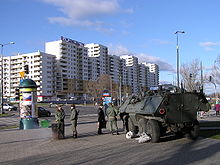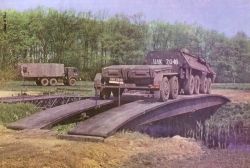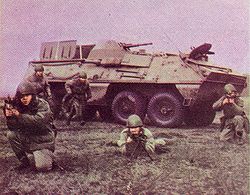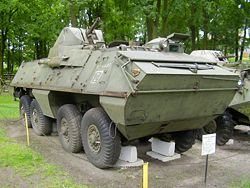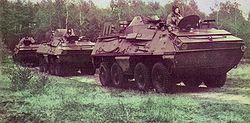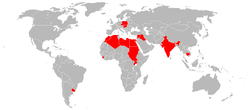- OT-64 SKOT
-
This article is about OT-64 SKOT. For SKOT, see Skot (disambiguation).
OT-64 SKOT 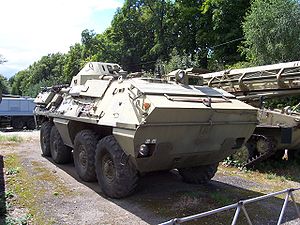
OT-64A SKOT-2AType Wheeled Amphibious Armored Personnel Carrier Place of origin  Czechoslovakia,
Czechoslovakia,
 Poland
PolandService history In service 1963 - present[1] Used by See Operators Wars See Service History Production history Designed 1959 Manufacturer Fabryka Samochodów Ciężarowych (FSC) (Poland)[1] Produced 1963 - early 1970s[1] Number built 4500[1] Variants See Variants Specifications Weight 14.5 t Length 7.44 m Width 2.55 m Height 2.71 m Crew 2 + 18 passengers[1]
2 + 10 passengers (OT-64A and SKOT-2A)[1]Armor 6-13 mm Main
armament7.62 mm PKT machine gun and 14.5 mm KPV machine gun. Engine air-cooled Tatra T-928-14 V-8 diesel
180 hpPower/weight 12.4 hp/tonne Suspension 8x8 Operational
range710 km Speed 94 km/h The OT-64 SKOT (Czech acronym for: Střední Kolový Obrněný Transportér, and/or Polish Średni Kołowy Opancerzony Transporter) is an amphibious armored personnel carrier (8x8), developed jointly by Poland and Czechoslovakia (ČSSR) well into the 1960s.
Contents
History
OT-64 was intended to replace the halftrack OT-810, which was nearly identical to the German SdKfz 251 from World War II. The first prototype was built in 1959. In 1961 the first sample series were built and starting from October 1963 the vehicles were produced in Lublin, Poland by Fabryka Samochodów Ciężarowych. Czechoslovakia supplied the driveline components, i.e. the engine, transmission and axles.
The first production vehicles were delivered in 1964 to both the Polish Army and Czechoslovak Army and many are still in use today. Both Polish and Czech units are gradually replaced by newer vehicles. Czech units are scheduled to be replaced between 2007 and 2012.
Technology
The OT-64's engine, transmission, suspension and axles were produced in Czechoslovakia. The engine was produced by Tatra and the semiautomatic transmission(shift now,transfer gear by pushing clutch later) by Praga. The armored hull and weapons were produced in Poland.
The OT-64 was the answer to the Soviet BTR-60. Contrary to this the OT-64 used a diesel set in place of a petrol engine. That diminished the danger of fire and at the same time increased the range. The main advantage in relation to the Russian counterpart was the full-armored interior. The entrance is at the rear of the vehicle via twin doors. The OT-64 was air-transportable and amphibious. For the amphibious drive the vehicle used two propellers installed at the back. The OT-64 had an NBC protection facility and night-vision equipment. It also has central inflation for all wheels which can be controlled by driver during a drive.
Several variants were built. Some OT-64 were re-equipped for air defense or built as tank hunters. The latter used the AT-3 Sagger missile as a weapon.
Service history
OT-64 SKOT entered service with Polish and Czechoslovak armies in 1963.It was produced until early 1970s. It still is in service with Poland, Czech Republic and Slovakia. OT-64 SKOT was also exported to eleven different countries (Algeria, Cambodia, India, Iraq, Libya, Morocco, Pakistan, Sierra Leone, Sudan, Syria, Uganda and Uruguay). A total number of vehicles produced for the Polish Army, the Czechoslovak Army and for export is 4,500.[1]
Variants
Czechoslovakia
- OT-64 - Original version, used in the APC role. Early models were unarmed but later the vehicle was fitted with a pintle-mounted 7.62 mm light machine gun or 12.7 mm DShK 1938/46 heavy machine gun. They used to be known in the West as respectively OT-64A and OT-64B. Some 12.7 mm DShK 1938/46 heavy machine gun armed OT-64 APCs had shields around the heavy machine gun mount.[1][2]
- OT-64 fitted with a small turret from OT-65A. However this one is armed with twin machine guns and doesn't have the 82mm T-21 "Tarasnice" recoilless gun.[2]
- DTP-64 (dilna technicke pomoci) - Czech repair version with tow bars, welding equipment and a hand operated crane with a capacity of 1 tonne. There were two sub-versions, namely the DTP-64/M for mechanized infantry units and the DTP-64/T for tank units. Photos
- OT-64 ZDRAV or ZDR-64 (zdravotni): ambulance.Photos
- OT-64A - Improved version fitted with BPU-1 turret from Soviet BRDM-2 armoured scout car which is armed with a 14.5 mm KPVT heavy machine gun and 7.62 mm PKT coaxial machine gun. In Western sources, this version is often called OT-64C. In the late 1990s, some vehicles had the turret replaced by a pintle-mounted machine gun for peace keeping operations.Photos The OT-64A is used as the basis for several command vehicles (velitelsko štábní obrněný transportér) fitted with multiple radio sets, a 1 kW generator and an antenna mast:
- VSOT-64/R2 R102 - Unarmed signals and command variant.
- VSOT-64/R2 R105 - Unarmed signals and command variant.
- VSOT-64/R2 R108 - Unarmed signals and command variant.
- VSOT-64/R2M - Signals and command variant with OT-64A's turret.Photos
- VSOT-64/R3 - Unarmed signals and command variant.
- VSOT-64/R3MT - Unarmed signals and command variant.Photos
- VSOT-64/R4MT - Unarmed signals and command variant.
- VSOT-64/R4RT - Unarmed signals and command variant.
- OT-64A fitted with the ATGM mounts on the turret sides.[2]
- OT-64A fitted with the new turret with higher elevation for armament. Similar to Polish SKOT-2AP.[2]
- OT-93 - Export version of the OT-64A with the original turret replaced by the one from the OT-65M or OT-62B. The armament consists of a single 7.62mm machine-gun.Photos
- Cobra - Infantry combat vehicle version with a new turret with 30mm gun 2A42. Did not enter production
Poland
OT-64 SKOT R-2M at the Polish Army Museum (Muzeum Wojska Polskiego)
- SKOT-1 - Early, unarmed model, similar to the OT-64.[1]
- SKOT-1A - SKOT-1 fitted with a superstructure in the front of the troop compartment. The superstructure a large, two piece hatch.[1]
- SKOT R-3 - Unarmed command vehicle used by regiment and higher command. It is equipped with 4 radios, 1 radio receiver, 1 microwave radio relay and 1 radiotelephone. The vehicle is operated by seven man crew.[1]
- SKOT R-3M - Unarmed signals and command variant for combat engineer units.
- SKOT R-3Z - SKOT R-3 with modernized radio equipment which it includes the second microwave radio relay.[1]
- SKOT R-4 - Unarmed command vehicle used by division and army command. It is equipped with 4 radios, 3 radio receivers and 3 radiotelephones.[1]
- SKOT-WPT (wóz pogotowia technicznego) - Technical support vehicle with a light crane.
- SKOT S-260 Art (artyleryjski) - Artillery tractor and transport vehicle for ammunition and mortar or anti-tank squads.
- SKOT S-260 Inż (inżynieryjny) - Fitted with racks for anti-tank mines and used to tow mechanical mine layers or mine-clearing systems.
- SKOT-2 - SKOT-1A with pintle MG mount around the hatch of the superstructure. Two types of machine guns were fitted there, 7.62 mm light machine gun (first SGMT and later PKT) or 12.7 mm DShK 1938/46 heavy machine gun. Sides of the machine gun mount are protected with armour plates.[1]
- SKOT-2A - Polish designator for the version with the BRDM-2 turret which was designed in late 1960s. The vehicle is fitted with conical turret armed with 14.5 mm KPV heavy machine gun and 7.62 mm PKT coaxial light machine gun on the top of the vehicle. Number of soldiers transported in the troop compartment went down from 18 to 10. In Western sources, this version is often called OT-64C.[1]
- SKOT 2AM - A small number of Polish SKOT-2A APCs was fitted with 9M14 Malyutka (AT-3 Sagger) ATGM launchers on the turret sides. The launchers were protected with armour plate or wire mesh. In the West, they were known as OT-64C(1A).[1]
- SKOT R-2 - Command vehicle used by battalion and regiment command. It is equipped with 4 radios: R-112, R-113 and 2 R-105. The vehicle is operated by seven man crew.[1]
- SKOT R-2AM - Unarmed command and fire control variant for artillery units.
- SKOT R-2M - Signals and command variant with SKOT-2A's turret.
- SKOT R-6 - Unarmed signals and command variant.
- SKOT-2AP - Polish modification with a new anti-aircraft WAT turret armed with 14.5 mm heavy machine gun. The turret had higher elevation for its armament and therefore could be used to fire at air targets. The turret has the new CGS-90 sight. This vehicle was known in the West as OT-64C(2).[1]
- SKOT-2A - Polish designator for the version with the BRDM-2 turret which was designed in late 1960s. The vehicle is fitted with conical turret armed with 14.5 mm KPV heavy machine gun and 7.62 mm PKT coaxial light machine gun on the top of the vehicle. Number of soldiers transported in the troop compartment went down from 18 to 10. In Western sources, this version is often called OT-64C.[1]
- SKOT R-3 - Unarmed command vehicle used by regiment and higher command. It is equipped with 4 radios, 1 radio receiver, 1 microwave radio relay and 1 radiotelephone. The vehicle is operated by seven man crew.[1]
- KTO WR-02 "Ryś" (KTO stands for Kołowy Transporter Opancerzony - Wheeled Armoured personnel Carrier) (Ryś - Lynx) - Heavily upgraded version with IVECO Cursor 8 engine. Work is performed by the 5th Military Mechanical Institute in Poznań.
- KTO WR-02 "Ryś-2" (KTO stands for Kołowy Transporter Opancerzony - Wheeled Armoured personnel Carrier) (Ryś-2 - Lynx-2) - The export version of KTO WR-02 "Ryś".
- SKOT-1A - SKOT-1 fitted with a superstructure in the front of the troop compartment. The superstructure a large, two piece hatch.[1]
Operators
Military operators
 Algeria - 400 OT-64 SKOT and BTR-60.[3]
Algeria - 400 OT-64 SKOT and BTR-60.[3] Cambodia - 40, however probably less are fully operational as only 140 of Cambodia's 266 APCs are fully operational. All the OT-64 APCs have apparently gone to the Phnom Penh reserve force and some are used by military police.
Cambodia - 40, however probably less are fully operational as only 140 of Cambodia's 266 APCs are fully operational. All the OT-64 APCs have apparently gone to the Phnom Penh reserve force and some are used by military police. Czech Republic - 28 OT-64 APCs in service as of 1 January 2008. They are scheduled to be replaced by new vehicles between 2007 and 2012.[4]
Czech Republic - 28 OT-64 APCs in service as of 1 January 2008. They are scheduled to be replaced by new vehicles between 2007 and 2012.[4] Hungary
Hungary Egypt - 300
Egypt - 300 India
India Libya
Libya Morocco
Morocco Poland - On beginning of the 1990s, SKOT's were gradually withdrawn from the Polish Army, and consists of around 300-400, in particular in the versions R-2AM/AMT (for artillery units) and R-3M, engineer's, school. The SKOT is being replaced by the KTO Rosomak. There were 110 SKOT APCs and SKOT based vehicles in service as of 2005.
Poland - On beginning of the 1990s, SKOT's were gradually withdrawn from the Polish Army, and consists of around 300-400, in particular in the versions R-2AM/AMT (for artillery units) and R-3M, engineer's, school. The SKOT is being replaced by the KTO Rosomak. There were 110 SKOT APCs and SKOT based vehicles in service as of 2005. Sierra Leone
Sierra Leone Slovakia
Slovakia Sri Lanka - OT-64 SKOT-based Command vehicles.
Sri Lanka - OT-64 SKOT-based Command vehicles. Sudan
Sudan Syria
Syria Uganda
Uganda Uruguay - 90
Uruguay - 90
Former Military Operators
 Czechoslovakia - Passed on to the successor states.
Czechoslovakia - Passed on to the successor states. Iraq - All destroyed or scrapped.
Iraq - All destroyed or scrapped.
Civilian Operators
- At least 2 SKOT APC's one in Czech Republic and one in Poland have been modified an are used as firefighting vehicles[5]
- Many SKOT APCs in Poland and the Czech Republic were sold to private owners who make sure they are in working condition and regularly show them on military enthusiast's meetings.[6] Some private Czech OT-64's have number plates and can travel on public roads.[7]
References
- ^ a b c d e f g h i j k l m n o p q r "Pancerni 1"
- ^ a b c d "JED The Military Equipment Directory"
- ^ Algerian army armyrecognition.com
- ^ "Czech Ministry of Defense"
- ^ Civilian versions of the OT-64 SKOT, www.specops.com.p
- ^ MILITARIUM - Wojsko Polskie - Uzbrojenie
- ^ Czech SKOT photos, www.specops.com.pl
- Jerzy Kajetanowicz - Polish Fighting Vehicles in Post-war period.
- Janusz Magnuski - Wozy Bojowe LWP 1943-1983 Wydawnictwo Miniterstwa Obrony Narodowej - ISBN 83-11-06990-5
- Technika Wojska Polskiego - Dom Wydawniczy Bellona - 1998
Literature
- Philip Terwhitt, “Tank”, New Emperor Publishing House, complaint ford, 2005, ISBN 3-7043-3197-X
External links
- Czech MoD official site
- English website for Russian Military Trucks
- www.globalsecurity.org: OT-64 (SKOT) (English)
- Panzermodelkit site
- SKOT (Polish)
- KTO Ryś (Polish)
- bharat-rakshak site
- OT-64 (Czech)
Main battle tanks Light tanks Infantry fighting vehicles Armoured personnel carriers Armored cars MRAPs Cougar HFour-wheel drive vehicles Self-propelled guns Rocket artillery Self-propelled anti-aircraft guns Self-propelled surface-to-air missile systems Tatra models Cars Civilian trucks: NW First Truck · 13 · 22 · 23 · 24 · 25 · 26 · 27 · 27B · 28 · 43 · 49 · 50 · 51 · 72 · 74 · 79 · 81 · 84 · 85 · 85A · 86 · 92 · 111 · 114 · 115 · 116 · 128 · 130 · 138 · 141 · 147 · 148 · 157 · 158 Phoenix · 163 Jamal · 400 · 401 · 500 · 700 · 805 · 810 · 813 · 815 · 815-2 · 816 · BetaMilitary trucks: Prototypes and racing cars: NW Rennzweier · 12 Targa Florio · 30 Sport · 90 · 137 · 201 · 600 Diesel · 601 Convertible · 601 Monte Carlo · 602 Tatraplan Sports · 603A · 603 B5 · 603 B6 · 603 MB · 603 Monte Carlo · 603 X · 604 · 605 · 607 · 607-2 · 625 · Baghira · Dolphin · JK 2500 · microbus · MTX V8 · Prezident · V570 · V855 · Jamal EvoCategories:- Armoured personnel carriers of the Cold War
- Armoured personnel carriers of Poland
- Weapons of Czechoslovakia
- Wheeled amphibious armoured fighting vehicles
- Wheeled armoured personnel carriers
- Tatra vehicles
- Czechoslovakia–Poland relations
- OT-64 - Original version, used in the APC role. Early models were unarmed but later the vehicle was fitted with a pintle-mounted 7.62 mm light machine gun or 12.7 mm DShK 1938/46 heavy machine gun. They used to be known in the West as respectively OT-64A and OT-64B. Some 12.7 mm DShK 1938/46 heavy machine gun armed OT-64 APCs had shields around the heavy machine gun mount.[1][2]
Wikimedia Foundation. 2010.


